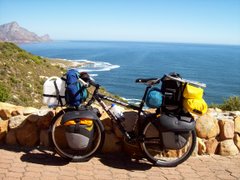




I found
Laos to be literally a breath of fresh air, the quiet road through the rolling tropical hills was in stark contrast to the “hustle & bustle” which is much of
Vietnam. Thus far the people seem extremely friendly, and there is a continuous chorus of “sapa-dii” (hello) emanating from the stilted bamboo houses (complete with satellite dish for TV reception). In these hill villages the younger children often run around naked (why not? – the climate is good and after a swim in the river they can simply “drip-dry”). As we’ve approached the
Mekong valley life appears to have become a bit more modern – but the locals remain friendly. My biggest problem is that my bike (Old Saartjie) is so worn-out that I can’t even use the middle chain ring anymore (a major problem on a hilly road!). I’ve looked around for spares, but around here there is nothing suitable (anyway, I don’t have any money). I spent almost an entire day paying some attention to Old Saartjie and fitting used spares which I've previously replaced on Leana's bike. I initially wrote and published this report in the town of
Savannakett on the Mekong river, where we spent 2 days (
Thailand is on the far banks - see recently-built Friendship II bridge in background of photo). Since then we have moved further up the Mekong to the town of Tha Khaek. Daily distances cycled in
Laos have been:- Xepon 54 km; Donghen 133 km; Savannakett 80 km; and Tha Khaek 131 km. Total distance cycled since Cape Town is 45650 km.




























